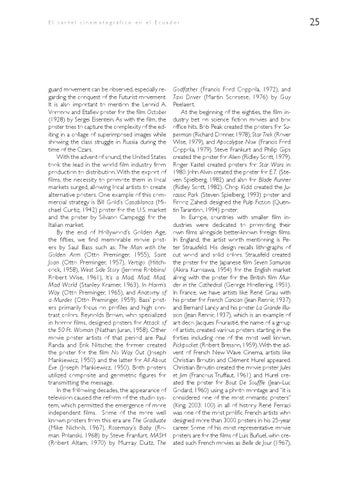El car tel cinematográfico en el Ecuador
guard movement can be observed, especially regarding the conquest of the Futurist movement. It is also important to mention the Leonid A. Voronov and Etafiev poster for the film October (1928) by Sergei Eisentein. As with the film, the poster tries to capture the complexity of the editing in a collage of superimposed images while showing the class struggle in Russia during the time of the Czars. With the advent of sound, the United States took the lead in the world film industry from production to distribution. With the expor t of films, the necessity to promote them in local markets surged, allowing local ar tists to create alternative posters. One example of this commercial strategy is Bill Gold’s Casablanca (Michael Cur tiz, 1942) poster for the U.S. market and the poster by Silvano Campeggi for the Italian market. By the end of Hollywood’s Golden Age, the fifties, we find memorable movie posters by Saul Bass such as: The Man with the Golden Arm (Otto Preminger, 1955), Saint Joan (Otto Preminger, 1957), Vertigo (Hitchcock, 1958), West Side Story (Jerome Robbins/ Rober t Wise, 1961), It’s a Mad, Mad, Mad, Mad World (Stanley Kramer, 1963), In Harm’s Way (Otto Preminger, 1965), and Anatomy of a Murder (Otto Preminger, 1959). Bass’ posters primarily focus on profiles and high contrast colors. Reynolds Brown, who specialized in horror films, designed posters for Attack of the 50 Ft. Woman (Nathan Juran, 1958). Other movie poster ar tists of that period are Paul Randa and Erik Nitsche; the former created the poster for the film No Way Out (Joseph Mankiewicz, 1950) and the latter for All About Eve (Joseph Mankiewicz, 1950). Both posters utilized composite and geometric figures for transmitting the message. In the following decades, the appearance of television caused the reform of the studio system, which permitted the emergence of more independent films. Some of the more well known posters from this era are The Graduate (Mike Nichols, 1967), Rosemary’s Baby (Roman Polanski, 1968) by Steve Franfur t, MASH (Rober t Altam, 1970) by Murray Duitz, The
Godfather (Francis Ford Coppola, 1972), and Taxi Driver (Mar tin Scorsese, 1976) by Guy Peelaer t. At the beginning of the eighties, the film industry bet on science fiction movies and box office hits. Bob Peak created the posters for Superman (Richard Donner, 1978), Star Trek (Rover Wise, 1979), and Apocalypse Now (Francis Ford Coppola, 1979). Steve Frankurt and Philip Gips created the poster for Alien (Ridley Scott, 1979). Roger Kastel created posters for Star Wars in 1980. John Alvin created the poster for E.T. (Steven Spielberg, 1982) and also for Blade Runner (Ridley Scott, 1982). Chop Kidd created the Jurassic Park (Steven Spielberg, 1993) poster and Firooz Zahedi designed the Pulp Fiction (Quentin Tarantino, 1994) poster. In Europe, countries with smaller film industries were dedicated to promoting their own films alongside better-known foreign films. In England, the artist worth mentioning is Peter Strausfeld. His design recalls lithographs of cut wood and solid colors. Strausfeld created the poster for the Japanese film Seven Samurais (Akira Kurosawa, 1954) for the English market along with the poster for the British film Murder in the Cathedral (George Hoellering, 1951). In France, we have artists like René Grau with his poster for French Cancan (Jean Renoir, 1937) and Bernard Lancy and his poster La Grande Illusion (Jean Renoir, 1937), which is an example of art deco. Jacques Fourastié, the name of a group of artists, created various posters starting in the forties including one of the most well known, Pickpocket (Robert Bresson, 1959). With the advent of French New Wave Cinema, artists like Christian Broutin and Clément Hurel appeared. Christian Broutin created the movie poster Jules et Jim (Francous Truffaut, 1961) and Hurel created the poster for Bout De Souffle (Jean-Luc Godard, 1960) using a photo montage and “it is considered one of the most romantic posters” (King, 2003: 100) in all of history. René Ferraci was one of the most prolific French artists who designed more than 3000 posters in his 25-year career. Some of his most representative movie posters are for the films of Luis Buñuel, who created such French movies as Belle de Jour (1967),
25
